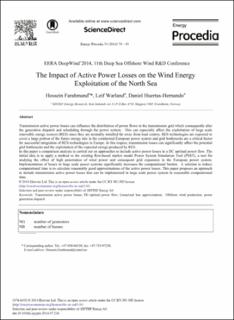| dc.contributor.author | Farahmand, Hossein | |
| dc.contributor.author | Warland, Leif | |
| dc.contributor.author | Huertas-Hernando, Daniel | |
| dc.date.accessioned | 2020-04-17T07:18:09Z | |
| dc.date.available | 2020-04-17T07:18:09Z | |
| dc.date.created | 2014-10-09T11:56:45Z | |
| dc.date.issued | 2014 | |
| dc.identifier.citation | Energy Procedia. 2014, 53 70-85. | en_US |
| dc.identifier.issn | 1876-6102 | |
| dc.identifier.uri | https://hdl.handle.net/11250/2651415 | |
| dc.description.abstract | Transmission active power losses can influence the distribution of power flows in the transmission grid which consequently alter the generation dispatch and scheduling through the power system. This can especially affect the exploitation of large scale renewable energy sources (RES) since they are normally installed far away from load centres. RES technologies are expected to cover a large portion of the future energy mix in the continental European power system and grid bottlenecks are a critical factor for successful integration of RES technologies in Europe. In this respect, transmission losses can significantly affect the potential grid bottlenecks and the exploitation of the expected energy produced by RES. In this paper a comparison analysis is carried out on approaches to include active power losses in a DC optimal power flow. The initial idea is to apply a method to the existing flow-based market model Power System Simulation Tool (PSST), a tool for studying the effect of high penetration of wind power and consequent grid expansion in the European power system. Implementation of losses in large scale power systems significantly increases the computational burden. A solution to reduce computational time is to calculate reasonably good approximations of the active power losses. This paper proposes an approach to include transmission active power losses that can be implemented in large scale power system in reasonable computational time. | en_US |
| dc.language.iso | eng | en_US |
| dc.rights | Attribution-NonCommercial-NoDerivatives 4.0 Internasjonal | * |
| dc.rights.uri | http://creativecommons.org/licenses/by-nc-nd/4.0/deed.no | * |
| dc.subject | Transmission active power losses | en_US |
| dc.subject | DC-optimal power flow | en_US |
| dc.subject | Linearized loss approximation | en_US |
| dc.subject | Offshore wind production | en_US |
| dc.subject | power generation dispatch | en_US |
| dc.title | The Impact of Active Power Losses on the Wind Energy Exploitation of the North Sea | en_US |
| dc.type | Peer reviewed | en_US |
| dc.type | Journal article | en_US |
| dc.description.version | publishedVersion | en_US |
| dc.source.pagenumber | 70-85 | en_US |
| dc.source.volume | 53 | en_US |
| dc.source.journal | Energy Procedia | en_US |
| dc.identifier.doi | 10.1016/j.egypro.2014.07.216 | |
| dc.identifier.cristin | 1162615 | |
| dc.relation.project | Norges forskningsråd: 193823 | en_US |
| cristin.unitcode | 7548,50,0,0 | |
| cristin.unitname | Energisystemer | |
| cristin.ispublished | true | |
| cristin.fulltext | original | |
| cristin.qualitycode | 1 | |

